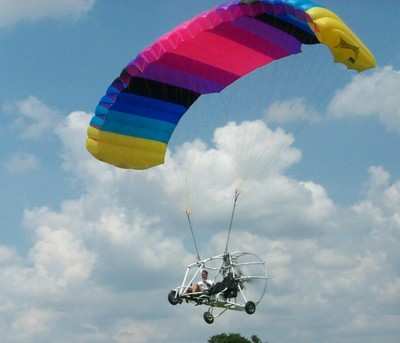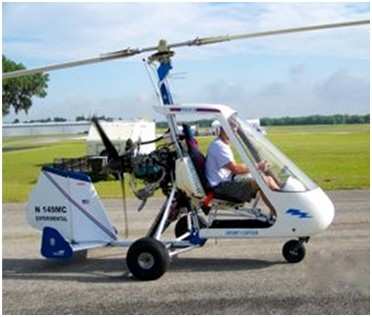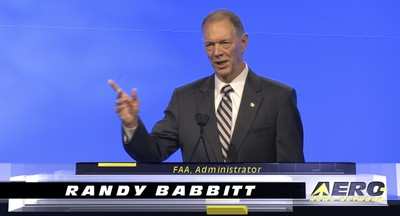...And Here, Darn it, Are The Heartbreakers
Final Compilation/Analysis by ANN E-Media Producer, Paul
Plack
 It is both the most "fun," and most
difficult task, facing the ANN staff at the end of every year --
determining who, or what, did the most to promote the cause of
aviation in the past 365 days... while also chastising those people
or entities that did all they could to undermine the many successes
the aerospace community has managed to accomplish.
It is both the most "fun," and most
difficult task, facing the ANN staff at the end of every year --
determining who, or what, did the most to promote the cause of
aviation in the past 365 days... while also chastising those people
or entities that did all they could to undermine the many successes
the aerospace community has managed to accomplish.
Alas, 2010 saw more than its fair share of downers, aviation-wise.
Sure, "stuff" happens... but a few folks, issues, or entities
seemed to go out of their way to create problems for the world of
aviation.
So... it is ANN's annual obligation to recognize a dozen
of our Aero-Heroes/Heartbreakers for 2010... in something of
an informal order -- Saving the 'best' for last.
Let us know what you think of our selections... whom YOU would
have liked be included, or omitted, from such a list. In the
meantime, we hope those who had something to do with this year's
selections think a little more positively about the welfare of this
industry, so that future lists become harder and harder to
catalog.
Be it ignorance, arrogance or just plain incompetence, these
were the folks or topics that made our lot a whole lot more
difficult and immeasurably injured the aviation world in the past
year.
Shame on those issues, folks, or groups that made our lot so
much tougher in 2010...
Aero-Heartbreakers: Agency Blocking Instruction for LSA and
Gyroplane Pilots
In speaking appearances during his first full year at the helm,
FAA Administrator Randy Babbitt tried in 2010 to sell the idea that
the agency is, for its size and mission, responsive, efficient, and
as light on the controls as its safety mandate allows. In rooms
filled mostly with operators of aircraft with standard
airworthiness certificates, that line sold pretty well. But for
pilots of experimental aircraft, especially the small ones which
are general aviation's entry level, Babbitt's comments were very
dark comedy.

The E-LSA Problem
Part of the problem dates back to the launch of Light Sport
Aircraft and the Sport Pilot certificate in 2005. At the time, the
FAA wanted to bring the two-seat, unregistered aircraft, then used
to train ultralight pilots, into the new Experimental Light Sport
Aircraft (E-LSA) tent. Subject to certain qualifications, they
could receive airworthiness inspections, be issued N-numbers, and
be used for training. The premise was that five years should be
plenty of time for instructors to replace their E-LSA trainers with
Special Light Sport Aircraft (S-LSA), which are factory assembled
to industry consensus standards. A deadline of January 31, 2010 was
set for two-place E-LSAs to be retired from training.
 But without the unlimited debt
facility enjoyed by the federal government, individuals and
companies are bound by market realities, and things didn't go
exactly as planned. Manufacturers of these small aircraft charged
significantly more for S-LSA versions of their E-LSAs, in part to
cover the ongoing administrative burden. Instructors, who in this
sector are almost exclusively Part 61 and part-time, saw machines
on showroom floors that looked exactly like what they had at home,
but at much higher prices. The market would not bear a steep
increase in instructional rates, especially after the economy
collapsed in 2008. So, most instructors in powered parachutes and
similar craft decided the only thing that penciled out was playing
chicken with the deadline. Surely the FAA wouldn't let the
availability of instruction in these aircraft wither, right?
But without the unlimited debt
facility enjoyed by the federal government, individuals and
companies are bound by market realities, and things didn't go
exactly as planned. Manufacturers of these small aircraft charged
significantly more for S-LSA versions of their E-LSAs, in part to
cover the ongoing administrative burden. Instructors, who in this
sector are almost exclusively Part 61 and part-time, saw machines
on showroom floors that looked exactly like what they had at home,
but at much higher prices. The market would not bear a steep
increase in instructional rates, especially after the economy
collapsed in 2008. So, most instructors in powered parachutes and
similar craft decided the only thing that penciled out was playing
chicken with the deadline. Surely the FAA wouldn't let the
availability of instruction in these aircraft wither, right?
The instructors lost that gamble, and so did the community they
once served. Instruction became much harder to find. Even Letters
of Deviation Authority (LODA) for training in experimentals, which
are a last resort under FAR 61.319(h) in cases of instructional
shortages, were unavailable, because in 2008 the FAA pulled its
guidelines under which Field Service District Offices (FSDO) could
issue the LODAs. Hit especially hard were would-be students for a
Sport Pilot rating in the under-80-knot segment which requires
specific training. Only four qualifying S-LSA trainers were
available in the US as of Fall, 2010.
EAA and other groups worked the backchannels, and it was widely
hoped the two-year LODA clot would be cleared in time for
AirVenture 2010. But the event came and went without a word.
Finally, in September of last year, new LODA guidelines were
issued. They allowed LODAs only for seven specific purposes, with
an eighth as a catch-all:
- Initial flight training for the operation of specific make and
model of experimental aircraft.
- Recurrent flight training for the operation of a specific make
and model of experimental aircraft.
- Primary flight training for the operation of ultralight
vehicles only when conducted in low mass, high drag vehicles with
an empty weight less than 500 pounds and a maximum speed in level
flight with maximum continuous power (VH) less than 87 knots
calibrated airspeed (CAS).
- Jet unusual attitude and upset training.
- Instrument competency training for specific make and model of
experimental aircraft.
- Training for a flight review in a specific make and model of
experimental aircraft.
- Formation training for specific make and model of experimental
aircraft.
- Other specific training approved by the General Aviation and
Commercial Division, AFS-800.
A couple of things jump out of this list. The only primary
training FSDOs may authorize is for ultralight vehicles - no
primary training for the FAA's own Sport Pilot certificate.
Recurrent training, transition training, flight reviews, even jet
and formation training are OK, but no way to prepare students for a
certificate.
Finally, in late October 2010, Steve Brandon of California
Powered Parachutes broke through, and got a LODA for a two-place,
E-LSA, powered parachute trainer under the catch-all specified at
the end of the list: "Other specific training approved by the
General Aviation and Commercial Division, AFS-800." In media
reports last fall, he noted that he was only able to get the LODA
because there was no equivalent S-LSA training aircraft in the
jurisdiction of the Oakland FSDO.

Steve's LODA states, "If the Responsible Person signing this LOA
(Letter of Authorization) relinquishes responsibility, this LOA
becomes invalid." The good news: The FAA is now in the business of
granting training monopolies for large geographic areas, so you'll
have no ceiling on your rates. The bad news: If you're successful
enough to attract a competitor with a S-LSA version of your
aircraft, or the person who signed your LODA decides to back out
for any reason, you could be out of business at any time. If you're
trying to buy a trainer based on a long-term business plan, that's
a non-starter.
The Unique Plight of Gyroplanes
If the situation is frustrating for would-be instructors in
fixed-wing E-LSAs, it is utterly ridiculous for gyroplane
instructors and students. As was the case in powered parachutes,
instruction in gyroplanes happened in "fat ultralights," but in the
case of gyros they were nearly always Experimental Amateur Built
(EAB) two-place machines, legal under an exemption through one of
the sport associations.

When Sport Pilot and LSA rulemaking took effect in 2005, the FAA
looked at the simplicity of light sport gyroplanes. These are
rotorcraft which have no complex, flight-critical transmissions,
are easy to fly, and typically have neither collective pitch
controls nor in-flight adjustable prop pitch. It was concluded
these were as simple as any fixed-wing aircraft. A Sport Pilot
Gyroplane certificate was made part of the rule.
But over in the FAA's Rotorcraft Directorate, where E-LSA and
S-LSA machines themselves would have to be approved, this was
deemed nonsense. Apparently unconvinced that construction and
stability standards would improve safety in the segment, this
bureau decided there would be no S-LSA gyroplanes permitted in the
marketplace. Gyroplane Sport Pilots could still fly EAB gyros which
met the speed, weight and other limits of LSA, but they'd have to
build their own.
Consensus gyroplane standards were developed through the ASTM
process, just as in fixed-wing, but instead of opening the S-LSA
market to gyro manufacturers willing to meet those standards, the
FAA grandfathered a few legacy designs as E-LSAs to use as the
long-term safety test fleet. None had demonstrated compliance with
the standards. Most could not. But somehow, in bureau-land, this
was a more valid test than allowing manufacturers to introduce
conforming machines. Go figure.

In any event, the end of any new training LODAs in 2008 hit
gyroplanes, too, only in this segment there were no certificated
trainers, and no S-LSA trainers. The Experimental Amateur Built
(EAB) gyros which make up the gyro training fleet have remained
available if they had LODAs issued before 2008, but as machines
wear out, gyroplane instructors have had no way to replace them.
There's theoretically the same "Section 8" path to LODAs for EAB
gyros that exists for E-LSAs, but it goes through the FAA's General
Aviation & Commercial Division, AFS-800, now managed by Mel
Cintron.
The Popular Rotorcraft Association's December, 2010 list of
active gyroplane CFIs shows only 13 instructors with available
training aircraft remaining in the entire US. Gyro pilots are often
getting Private or Sport Pilot airplane add-ons, just so they'll be
able to rent something for flight reviews. There are only three US
Designated Pilot Examiners for gyroplane, and only one has access
to an aircraft. This crisis is not just a Sport Pilot issue. This
is also the fleet that serves candidates for the Recreational,
Private, Commercial and Instructor certificates.
If Administrator Babbitt's contention is that his agency is only
as suffocating as it needs to be to fulfill its safety mandate, a
bunch of people under his stewardship didn't get the memo. The
dream to fly doesn't surrender easily to bureaucratic barriers, and
powered parachutes and gyroplanes are fun, affordable, safe ways to
fly low and slow. E-LSA and EAB trainers do not appear to be
statistically more dangerous than S-LSA. If you want to see real
danger, watch someone fly without training. Opportunities will be
getting more frequent.

We appear headed back to the unfortunate legacy of the era of
the Bensen Gyrocopter, which came with a self-training syllabus in
a three-ring binder, and predictable results. The ultralight 'chute
crowd has also worked to improve its safety culture. All the
progress made in the last 20 years of reinforcing the value of dual
training in gyros and PPCs may quickly be undone.
 ANN's Daily Aero-Linx (04.13.24)
ANN's Daily Aero-Linx (04.13.24) ANN's Daily Aero-Term (04.13.24): Beyond Visual Line Of Sight (BVLOS)
ANN's Daily Aero-Term (04.13.24): Beyond Visual Line Of Sight (BVLOS) Airborne 04.09.24: SnF24!, Piper-DeltaHawk!, Fisher Update, Junkers
Airborne 04.09.24: SnF24!, Piper-DeltaHawk!, Fisher Update, Junkers Aero-News: Quote of the Day (04.14.24)
Aero-News: Quote of the Day (04.14.24) ANN's Daily Aero-Term (04.14.24): Maximum Authorized Altitude
ANN's Daily Aero-Term (04.14.24): Maximum Authorized Altitude









